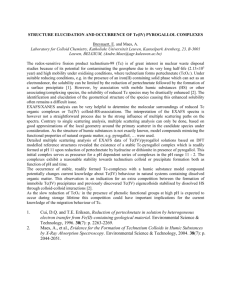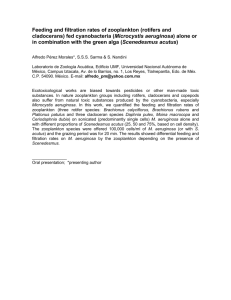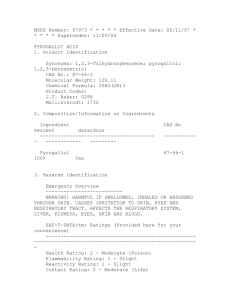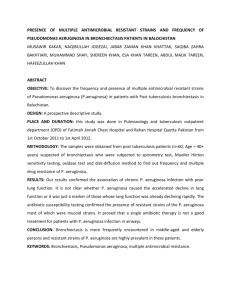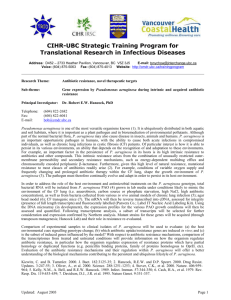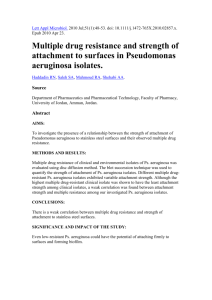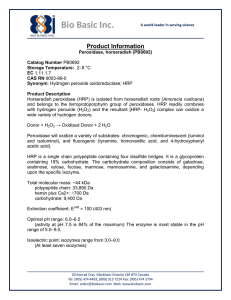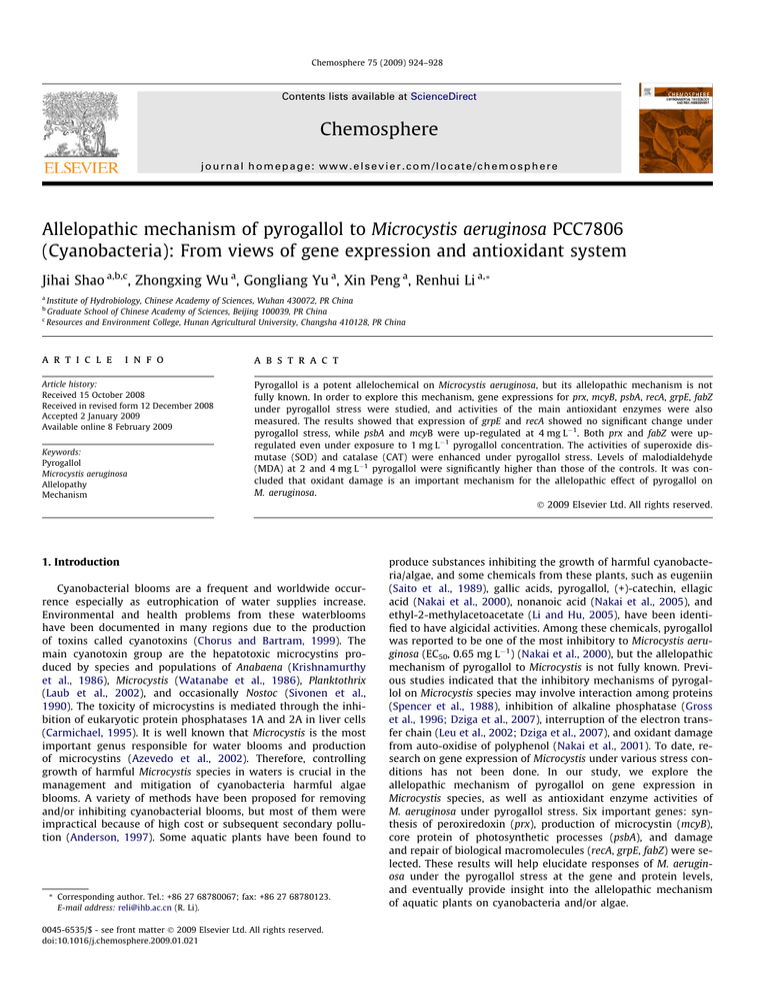
Chemosphere 75 (2009) 924–928
Contents lists available at ScienceDirect
Chemosphere
journal homepage: www.elsevier.com/locate/chemosphere
Allelopathic mechanism of pyrogallol to Microcystis aeruginosa PCC7806
(Cyanobacteria): From views of gene expression and antioxidant system
Jihai Shao a,b,c, Zhongxing Wu a, Gongliang Yu a, Xin Peng a, Renhui Li a,*
a
Institute of Hydrobiology, Chinese Academy of Sciences, Wuhan 430072, PR China
Graduate School of Chinese Academy of Sciences, Beijing 100039, PR China
c
Resources and Environment College, Hunan Agricultural University, Changsha 410128, PR China
b
a r t i c l e
i n f o
Article history:
Received 15 October 2008
Received in revised form 12 December 2008
Accepted 2 January 2009
Available online 8 February 2009
Keywords:
Pyrogallol
Microcystis aeruginosa
Allelopathy
Mechanism
a b s t r a c t
Pyrogallol is a potent allelochemical on Microcystis aeruginosa, but its allelopathic mechanism is not
fully known. In order to explore this mechanism, gene expressions for prx, mcyB, psbA, recA, grpE, fabZ
under pyrogallol stress were studied, and activities of the main antioxidant enzymes were also
measured. The results showed that expression of grpE and recA showed no significant change under
pyrogallol stress, while psbA and mcyB were up-regulated at 4 mg L1. Both prx and fabZ were upregulated even under exposure to 1 mg L1 pyrogallol concentration. The activities of superoxide dismutase (SOD) and catalase (CAT) were enhanced under pyrogallol stress. Levels of malodialdehyde
(MDA) at 2 and 4 mg L1 pyrogallol were significantly higher than those of the controls. It was concluded that oxidant damage is an important mechanism for the allelopathic effect of pyrogallol on
M. aeruginosa.
Ó 2009 Elsevier Ltd. All rights reserved.
1. Introduction
Cyanobacterial blooms are a frequent and worldwide occurrence especially as eutrophication of water supplies increase.
Environmental and health problems from these waterblooms
have been documented in many regions due to the production
of toxins called cyanotoxins (Chorus and Bartram, 1999). The
main cyanotoxin group are the hepatotoxic microcystins produced by species and populations of Anabaena (Krishnamurthy
et al., 1986), Microcystis (Watanabe et al., 1986), Planktothrix
(Laub et al., 2002), and occasionally Nostoc (Sivonen et al.,
1990). The toxicity of microcystins is mediated through the inhibition of eukaryotic protein phosphatases 1A and 2A in liver cells
(Carmichael, 1995). It is well known that Microcystis is the most
important genus responsible for water blooms and production
of microcystins (Azevedo et al., 2002). Therefore, controlling
growth of harmful Microcystis species in waters is crucial in the
management and mitigation of cyanobacteria harmful algae
blooms. A variety of methods have been proposed for removing
and/or inhibiting cyanobacterial blooms, but most of them were
impractical because of high cost or subsequent secondary pollution (Anderson, 1997). Some aquatic plants have been found to
* Corresponding author. Tel.: +86 27 68780067; fax: +86 27 68780123.
E-mail address: reli@ihb.ac.cn (R. Li).
0045-6535/$ - see front matter Ó 2009 Elsevier Ltd. All rights reserved.
doi:10.1016/j.chemosphere.2009.01.021
produce substances inhibiting the growth of harmful cyanobacteria/algae, and some chemicals from these plants, such as eugeniin
(Saito et al., 1989), gallic acids, pyrogallol, (+)-catechin, ellagic
acid (Nakai et al., 2000), nonanoic acid (Nakai et al., 2005), and
ethyl-2-methylacetoacetate (Li and Hu, 2005), have been identified to have algicidal activities. Among these chemicals, pyrogallol
was reported to be one of the most inhibitory to Microcystis aeruginosa (EC50, 0.65 mg L1) (Nakai et al., 2000), but the allelopathic
mechanism of pyrogallol to Microcystis is not fully known. Previous studies indicated that the inhibitory mechanisms of pyrogallol on Microcystis species may involve interaction among proteins
(Spencer et al., 1988), inhibition of alkaline phosphatase (Gross
et al., 1996; Dziga et al., 2007), interruption of the electron transfer chain (Leu et al., 2002; Dziga et al., 2007), and oxidant damage
from auto-oxidise of polyphenol (Nakai et al., 2001). To date, research on gene expression of Microcystis under various stress conditions has not been done. In our study, we explore the
allelopathic mechanism of pyrogallol on gene expression in
Microcystis species, as well as antioxidant enzyme activities of
M. aeruginosa under pyrogallol stress. Six important genes: synthesis of peroxiredoxin (prx), production of microcystin (mcyB),
core protein of photosynthetic processes (psbA), and damage
and repair of biological macromolecules (recA, grpE, fabZ) were selected. These results will help elucidate responses of M. aeruginosa under the pyrogallol stress at the gene and protein levels,
and eventually provide insight into the allelopathic mechanism
of aquatic plants on cyanobacteria and/or algae.
J. Shao et al. / Chemosphere 75 (2009) 924–928
925
1989; Bustin, 2000). The induction ratio was calculated using
2DDCt where DDct = (Ct, target gene Ct, 16S rrn) stress (Ct, target gene
Ct, 16S rrn) control according to the handbook of ABI Prism 7000
SDS software.
2. Materials and methods
2.1. Strain and culture conditions
M. aeruginosa PCC 7806 was originally obtained from the Pasteur Culture Collection of Cyanobacteria in France and kindly provided by the Freshwater Algae Culture Collection of the Chinese
Academy of Sciences. The strain was grown in BG11 liquid medium
(pH 9) (Rippka et al., 1979), under a 12:12 LD cycle with an intensity of 30 lmol photons s1 m2 provided by cool white fluorescent tubes at 25 ± 1 °C. Pyrogallol (AR) was purchased from
Sinopharm Group Chemical Reagent Ltd. (Shanghai, China). Experiments were carried out in 250 mL conical flasks containing
99.9 mL BG11 liquid medium, 100 lL of combined stock pyrogallol
solutions and H2O (stock solution of pyrogallol were freshly made
up in water prior to use) to obtain pyrogallol concentrations as 0, 1,
2, 4 mg L1 respectively. Each treatment was replicated three
times, and the initial cyanobacterial concentration was 5.2 104
cell mL1. All treatments were cultured in the light at 30 lmol
photons s1 m2 at 25 ± 1 °C for 12 h.
2.2. RNA extraction
M. aeruginosa PCC 7806 cells were harvested, after 12 h exposure to pyrogallol, by centrifuging them at 7000 rpm for 5 min. Pelleted cells were resuspended in Trizol reagent (Invitrogen USA),
and homogenized with a mini-beadbeater. Total RNAs were extracted following the Trizol reagent manual (Invitrogen, USA).
2.3. Reverse transcription
Total RNAs were digested with RQ1 RNase-free DNase (Promega
USA). These DNase treated RNAs were reverse transcripted to
cDNA using random primers p(dN)9 and a reverse transcriptase
kit (Generay, China).
2.4. Primer design and real-time PCR
PCR primers designed for six genes are listed in Table 1, with the
16S rRNA gene as the control. Real-time PCR was performed with
10 lL Master Mix (SYBR Green, TOYOBO, Japan), 0.2 lL
(10 pmol lL1) forward primer and reverse primer respectively,
1 lL cDNA, the final volumes were 20 lL. The amplification reactions were performed by an ABI Prism 7000 Sequence Detect System (Applied Biosystems USA) under the following conditions: one
cycle at 95 °C for 3 min, followed by 40 cycles of 95 °C for 15 s,
59 °C for 30 s, 72 °C for 30 s. Gene expression data from Real-time
PCR were evaluated using Ct value (Livak and Schmittgen, 2001),
and the 16S rRNA gene was used as the housekeeping gene to normalize the expression levels of target genes, since the expression of
16S rRNA is stable under the various conditions (Barbu and Dautry,
2.5. Malodialdehyde (MDA), superoxide dismutase (SOD) and catalase
(CAT) assays
Lipid peroxidation product as malodialdehyde (MDA) was measured spectrophotometrically using the thiobarbituric acid method
(Uchimaya and Mihara, 1978). Total SOD activity was determined
by nitroblue terazolium (NBT) photoreduction (Beauchamp and
Frodovich, 1971), and this enzymic activity was expressed as units
of SOD activity per microgram protein, where 1 U of SOD is defined
as the amount of enzyme required for 50% inhibition of Cyt c
reduction. The assay for antioxidant enzyme-catalase (CAT) activity was based on its ability to decompose H2O2, with the absorbance of supernatant at 240 nm (Choo et al., 2004).
2.6. Statistics
Significant differences between control and treated samples
were determined using the t- test. Differences were considered
to be significant at p < 0.05.
3. Results and discussion
3.1. Gene expression of M. aeruginosa PCC 7806 under pyrogallol stress
prx is a gene encoding for peroxiredoxin (Prx), a 25-kDa protein
which was first discovered in yeast (Chae et al., 1994), and belongs
to the thiol oxidation system. Prx could catalyze the reduction of
H2O2, alkyl hydroperoxides, and peroxynitrite, using thioredoxin
and other thiol containing reducing agents as electron donors
(Wood et al., 2003). As shown in Fig. 1, expression of prx, in response to pyrogallol stress, was found to be up-regulated even at
1 mg L1. The relative normalized expression of prx at pyrogallol
concentrations of 2 and 4 mg L1, were 3.6 and 7.2 times of the
control. prx plays important biological roles, since peroxiredoxins
are highly conserved in eukaryotes and prokaryotes (Kim et al.,
1996). Genomic analysis studies have indicated that multigenic
families of prx-s exist in cyanobacteria and play important roles
in their biological processes (Stork et al., 2005). For example, a mutant of cyanobacterium Anabaena PCC 7120 that fails to synthesize
PrxQ-A was found to be highly sensitive to oxidative stress, and
this hypersensitivity of the mutant was restored by inducing the
Table 1
Primers designed for real-time PCR.
Gene
name
Forward primer (50 -30 )
Reverse primer (50 -30 )
16S rrn
prx
psbA
mcyB***
recA
grpE
fabZ
GGACGGGTGAGTAACGCGTA*
GCGAATTTAGCAGTATCAACACC
GGTCAAGARGAAGAAACCTACAAT
CCTACCGAGCGCTTGGG
TAGTTGACCAGTTAGTGCGTTCTT
CGCAAACGCACAGCCAAGGAA
TGTTAATTGTGGAATCCATGG
CCCATTGCGGAAAATTCCCC**
GCGGTGCTGATTTCTTTTTTC
GTTG AAACCGTTGAGGTTGAA
GAAAATCCCCTAAAGATTCCTGAGT
CACTTCAGGATTGCCGTAGGT
GTGAATACCCATCTCGCCATC
TTGCTTCCCCTTGCATTTT
*
**
***
Modified according to Urbach et al. (1992).
Modified according to Nübel et al. (1997).
Kurmayer and Kutzenberger (2003).
Fig. 1. Relative normalized expression of prx of M. aeruginosa PCC 7806 under
pyrogallol stress. The horizontal axis is the concentrations of pyrogallol in BG11
medium. The error bar is the mean ± standard deviation. * is the p < 0.05 (t-test
between control and pyrogallol stress samples).
926
J. Shao et al. / Chemosphere 75 (2009) 924–928
Fig. 2. Relative normalized expression of mcyB of M. aeruginosa PCC 7806 under
pyrogallol stress. The horizontal axis is the concentration of pyrogallol in BG11
medium. The error bar is the mean ± standard deviation. * is the p < 0.05 (t-test).
expression of the prxQ-A gene in trans (Latifi et al., 2007). The upregulated expression of prx in M. aeruginosa PCC 7806 under pyrogallol stress implied that oxidant damage may be the mechanism
for the allelopathy of pyrogallol to Microcystis cells.
mcyB is a gene belonging to gene cluster mcyA-J responsible for
the synthesis of microcystins in a number of cyanobacterial genera
(Pearson and Neilan, 2008). Compared to controls, expression of
mcyB at pyrogallol concentrations of 1 and 2 mg L1 showed little
variation, but did show a slight up-regulation at 4 mg L1 (Fig. 2).
It has been reported that many environmental factors affect the
synthesis of microcystins in Microcystis species. Iron deficiency,
for instance, resulted in an increase of microcystin-LR content relative to total protein in M. aeruginosa (Beatriz et al., 2006). High
light intensity has also been found to increase the transcription
of mcyB and mcyD (Kaebernick et al., 2000). To our knowledge,
the present study is the first report to demonstrate that pyrogallol
could up-regulate the expression of mcyB. Dziga et al. (2007) reported pyrogallol stress could increase microcystin content in the
culture medium of M. aeruginosa, and they explained this phenomenon as resulting from the release of this hepatotoxin from dead
Microcystis cells. Our results suggested that the up-regulated
expression of mcy gene maybe was another reason responsible
for the increase of the microcystin contents in the cultural medium
of M. aeruginosa beside the release of the microcystin from dead
cells. The results also suggested that water safety should be considered when Microcystis forming blooms were planned to be controlled by using pyrogallol or by using aquatic macrophytes with
high contents of pyrogallol.
To explore whether damages to photosynthetic processes, DNA,
protein, and cell membrane occurred under pyrogallol stress, psbA,
recA, grpE and fabZ were selected as target genes in this research.
psbA encodes D1 protein, a key subunit of Photosystem II (PS II)
(Aro et al., 1993). Results of the expression analysis of psbA in response to the pyrogallol stress are shown in Fig. 3. The expression
of psbA did not show a significant variation at 1 and 2 mg L1, but
the relative normalized expression of psbA at a concentration of
Fig. 3. Relative normalized expression of psbA, recA, grpE and fabZ of M. aeruginosa
PCC 7806 under pyrogallol stress. ( ) 0, ( ) 1, ( ) 2, ( ) 4 mg L1. The error
bar is the mean ± standard deviation. * is the p < 0.05 (t-test).
4 mg L1 pyrogallol was 6.9 times of the control. PS II has been
known to be very sensitive to changes in the environment, and
the degree of the repair for PS II is determined by the rate of synthesis for the D1 protein de novo (Aro et al., 1993). Photoinhibition
would usually not be observed if repairing rate keeps pace with
photodamage rate. However, if photodamage rate exceeds repair,
then net photoinhibition could be observed (Madhavi et al.,
2007). Pyrogallol stress has been found to inhibit the oxygen evolution of M. aeruginosa (Dziga et al., 2007), and it was also shown
that the repair rate did not keep up with the damage rate under
pyrogallol stress. The synthesis of mature D1 protein involves transcription and translation of psbA and transfer of the precursor (preD1) to the D1. Nishiyama et al. (2004) reported that singlet oxygen
molecules could inhibit the repair of PS II by suppressing translation elongation of the D1 protein. As shown in our results, the synthesis of psbA mRNA was up-regulated at a concentration of
4 mg L1, suggesting that the photosynthetic processes in M. aeruginosa PCC7806 had already sensed the pyrogallol stress. The block
in elongation of the D1 protein, as described by Nishiyama et al.
(2004), probably caused not enough mature D1 to substitute for
the damaged ones, which may stimulate cells to transcript more
psbA mRNA. Consequently, this may be the reason for the up-regulation of psbA in M. aeruginosa under pyrogallol stress. The
expression of recA and grpE showed no significant change under
all pyrogallol stress treatments, while that of fabZ was found to
be up-regulated even at a concentration of 1 mg L1 pyrogallol.
recA is a gene encoding RecA, which forms filaments on the single-stranded DNA. In this activated form, RecA protein functions
as a coprotease and stimulates the cleavage of LexA and several
other proteins, and then leads to initiation of SOS repairing of
DNA (Khil and Camerini-Otero, 2002). Many studies reported that
the expression of recA was up-regulated in various environmental
stresses such as hydrogen peroxide (Robert and Gu, 2004), 1,
1- dimethylhydrazine (Zavilgelsky et al., 2007) and mitomycin C
(Khil and Camerini-Otero, 2002). However, our results showed no
obvious up-regulation in expression of recA at pyrogallol concentrations below 4 mg L1. One explanation for this phenomenon is
that the damage from pyrogallol on M. aeruginosa PCC 7806 was
not severe enough that Microcystis cells initiate SOS repair of
DNA since the SOS repair of DNA is an error-prone manner in
DNA (Sundin and Weigand, 2007). And this was initiated only under conditions of severe DNA damage. Liu et al. (2007) showed that
cell density of toxic M. aeruginosa was only reduced 1.6% after a 2-d
exposure to pyrogallol at a concentration of 4.5 mg L1 in BG11
medium, thus reflecting that M. aeruginosa was not severely damaged in concentrations less than 4.5 mg L1. grpE is a gene encoding the heat-shock protein GrpE belonging to DnaK-DnaJ-GrpE
chaperone system, and this system has been known to protect proteins against heat-induced protein aggregation. Severe oxidative
stress conditions often lead to the expression of molecular chaperones and proteases (VanBogelen et al., 1987). Gawande and Griffiths (2005) reported that grpE promoters of Escherichia coli were
up-regulated in oxidative stress, and phenol stress also slightly
up-regulated the expression of protein grpE (Santos et al., 2004).
Expression of grpE in E. coli was also found to be significantly upregulated under H2O2 stress (Kim et al., 2007). According to our results, the expression of grpE did not significantly change under
pyrogallol stress, which implied that the intracellular proteins
are not severely denatured from pyrogallol stress at concentrations
below 4 mg L1. fabZ belongs to fatty acid biosynthesis (FAS) II,
encoding b-hydroxyacyl acyl carrier protein (ACP) dehydratase,
which efficiently catalyzes the dehydration of short chain-hydroxyacyl-ACPs and long chain saturated and unsaturated-hydroxyacyl-ACPs (Swarnamukhi et al., 2006). The lipid membranes most
susceptible to oxidation are those containing polyunsaturated fatty
acids (Floyd, 1990). The up-regulated expression of fabZ obtained
J. Shao et al. / Chemosphere 75 (2009) 924–928
Fig. 4. MDA content of M. aeruginosa PCC 7806 under pyrogallol stress. The
horizontal axis is the concentrations of pyrogallol in BG11 medium. The error bar is
the mean ± standard deviation. * is the p < 0.05 (t-test).
in this study suggested that membranes may undergo oxidant
damage under the pyrogallol stress. In order to confirm this speculation, the malodialdehyde (MDA) concentration in M. aeruginosa
PCC7806 cells under pyrogallol stress were determined, and the results are shown in Fig. 4. Compared with the control, MDA content
was significantly higher at concentrations of 2 and 4 mg L1 pyrogallol, demonstrating that the polyunsaturated fatty acids underwent oxidative damage since MDA is the oxidative product of
unsaturated fatty acids. In order to maintain the normal function
of membranes, more unsaturated fatty acids need to be integrated
into membranes, which would cause the obvious up-regulation in
expression of fabZ. These findings also supported the hypothesis
that oxidant damage is the mechanism for the allelopathy of pyrogallol to Microcystis. As shown in the expression responses of recA,
grpE and fabZ under the pyrogallol stress, fabZ was found to be
more sensitive than the other two genes, and this difference could
be explained in that membranes related to fabZ function are the
outer constitutes of cell, and are the first target for oxidative
damage.
3.2. Activities of antioxidant enzymes of M. aeruginosa PCC 7806 under
pyrogallol stress
These results of gene expression demonstrated above suggest
that oxidant damage may be an important mechanism for the allelopathy of pyrogallol to Microcystis cells. In order to further confirm
this hypothesis, we determined the superoxide dismutase (SOD)
and catalase (CAT) of M. aeruginosa PCC7806 under pyrogallol
stress. SOD and CAT are representatives for the most important
antioxidant enzymes in cells. SOD catalyzes the dismutation of
the superoxide radical into H2O2 and O2 (Valentine et al., 1998),
and CAT catalyzes the H2O2 into H2O and O2 (Zamocky et al.,
2008). By collaboration between these two enzymes, cells could
927
Fig. 6. CAT Activity of M. aeruginosa PCC 7806 under pyrogallol stress. The
horizontal axis is the concentrations of pyrogallol in BG11 medium. The error bar is
the mean ± standard deviation. * is the p < 0.05 (t-test).
eliminate or reduce the toxicity of superoxide radical and H2O2.
The activities of SOD and CAT in responding to the pyrogallol stress
are shown in Figs. 5 and 6. Compared with controls, the activities of
both SOD and CAT were enhanced under pyrogallol stress. It is well
known that most environmental stress affect production of active
oxygen species in plants and therefore cause oxidative stress
(Smirnoff, 1993). Cellular activities of SOD and CAT have always
been reported to be elevated under oxidant stress, and nitrogenfixing cyanobacteria have been found to increase both SOD and
CAT activities under endosulfan stress (Kumar et al., 2008). Copper
stress, could also stimulate activities of SOD and CAT in green alga
Pavlova viridis (Li et al., 2006). Therefore, the enhancement of SOD
and CAT activities presented in this study suggested that Microcystis cells encountered oxidant stress when exposed to pyrogallol,
further supporting the hypothesis that oxidant damage is an
important mechanism for the allelopathy of pyrogallol to Microcystis species.
4. Conclusion
Results from expression of both prx and fabZ genes, and in SOD
and CAT activities support the hypothesis that oxidant damage is
an important mechanism for the allelopathic effect of pyrogallol
on M. aeruginosa.
The expression analyses of psbA, recA, grpE and fabZ indicated
that membranes are the first target for the damage of pyrogallol
to Microcystis, and the D1 protein in photosynthetic processes is
another important target for the damage of pyrogallol to
Microcystis.
Pyrogallol can up-regulate expression of the microcystin synthesis gene mcyB of M. aeruginosa, suggesting that water safety
should be monitored when Microcystis blooms are being controlled
using pyrogallol or macrophytes with high contents of pyrogallol.
Acknowledgements
The present research is supported by the Frontier Research Project of the Chinese Academy of Sciences.
References
Fig. 5. SOD Activity of M. aeruginosa PCC 7806 under pyrogallol stress. The
horizontal axis is the concentrations of pyrogallol in BG11 medium. The error bar is
the mean ± standard deviation. * is the p < 0.05 (t-test).
Anderson, D.M., 1997. Turning back the harmful red tides. Nature 38, 513–514.
Aro, E.M., Virgin, I., Andersson, B., 1993. Photoinhibition of photosystem II.
Inactivation, protein damage and turnover. Biochim. Biophys. Acta 1143, 113–
134.
Azevedo, S.M.F.O., Carmichael, W.W., Jochimsen, E.M., Rinehart, K.L., Lau, S., Shaw,
G.R., Eaglesham, G.K., 2002. Human intoxication by microcystins during renal
dialysis treatment in Caruaru, Brazil. Toxicology 181–182, 441–446.
Barbu, V., Dautry, F., 1989. Northern blot normalization with a 28S rRNA
oligonucleotide probe. Nucleic Acids Res. 17, 7715.
928
J. Shao et al. / Chemosphere 75 (2009) 924–928
Beatriz, M.L., Sevilla, E., Hernandez, J.A., Bes, M.T., Fillat, M.F., Peleato, M.L., 2006. Fur
from Microcystis aeruginosa binds in vitro promoter regions of the microcystin
biosynthesis gene cluster. Phytochemistry 67, 876–881.
Beauchamp, C., Frodovich, I., 1971. Superoxide dismutase: improved assays and an
assays applicable acrylamide gels. Anal. Biochem. 44, 276–287.
Bustin, S.A., 2000. Absolute quantification of mRNA using real-time reverse
transcription polymerase chain reaction assays. J. Mol. Endocrinol. 25, 169–193.
Carmichael, W.W., 1995. Toxic Microcystis in the environment. In: Watanabe, M.F.,
Harada, K., Carmichael, W.W., Fujiki, H. (Eds.), Toxic Microcystis. CRC Press, New
York, pp. 1–12.
Chae, H.Z., Chung, S.J., Rhee, S.G., 1994. Thioredoxin-dependent peroxide reductase
from yeast. J. Biol. Chem. 269, 26768–27670.
Choo, K.S., Snoeijs, P., Pedersen, M., 2004. Oxidative stress tolerance in the
filamentous green algae Cladophora glomerata and Enteromorpha ahlneriana. J.
Exp. Mar. Biol. Ecol. 298, 111–123.
Chorus, I., Bartram, J., 1999. Toxic cyanobacteria in water: a guide to their public
health consequences, monitoring and management. WHO, E & FN, Spon,
London, UK.
Dziga, D., Suda, M., Bialczyk, J., Urszula, C.P., Lechowski, Z., 2007. The alteration of
Microcystis aeruginosa biomass and dissolved microcystin-LR concentration
following exposure to plant-producing phenols. Environ. Toxicol. 22, 341–346.
Floyd, R.A., 1990. Role of oxygen free radicals in carcinogenesis and brain ischemia.
FASEB 4, 2587–2597.
Gawande, P.V., Griffiths, M.W., 2005. Effects of environmental stresses on the
activities of the uspA, grpE and rpoS promoters of Escherichia coli O157:H7. Inter.
J. Food Microbiol. 99, 91–98.
Gross, E.M., Meyer, H., Schilling, G., 1996. Release and ecological impact of algicidal
hydrolysable polyphenols in Myriophyllum spicatum. Phytochemistry 41, 133–
138.
Kaebernick, M., Neilan, B.A., Börner, T., Dittmann, E., 2000. Light and the
transcriptional response of the microcystin biosynthesis gene cluster. Appl.
Environ. Microbiol. 66, 3387–3392.
Khil, P.P., Camerini-Otero, R.D., 2002. Over 1000 genes are involved in the DNA
damage response of Escherichia coli. Mol. Microb. 44, 89–105.
Kim, H.K., Kim, S.J., Lee, J.W., Cha, M.K., Kim, I.H., 1996. Identification of promoter in
the 50-flanking region of the E. coli thioredoxin-liked thiol peroxidase gene:
evidence for the existence of oxygen-related transcriptional regulatory protein
Biochem. Biophys. Res. Commun. 221, 641–646.
Kim, Y.S., Min, J., Hong, H.N., Park, J.H., Park, K.S., Gua, M.B., 2007. Gene expression
analysis and classification of mode of toxicity of polycyclic aromatic
hydrocarbons (PAHs) in Escherichia coli. Chemosphere 66, 1243–1248.
Krishnamurthy, T., Carmichael, W.W., Sarver, E.W., 1986. Investigations of
freshwater cyanobacteria (blue-green algae) toxic peptides. I. Isolation,
purification and characterization of peptides from Microcystis aeruginosa and
Anabaena flos-aquae. Toxicon 24, 865–873.
Kumar, S., Habib, K., Fatma, T., 2008. Endosulfan induced biochemical changes in
nitrogen-fixing cyanobacteria. Sci. Total. Environ. 403, 130–138.
Kurmayer, R., Kutzenberger, T., 2003. Application of real-time PCR for quantification
of microcystin genotypes in a population of the toxic cyanobacterium
Microcystis sp. Appl. Environ. Microbiol. 69, 6723–6730.
Laub, J., Henriksen, P., Brittain, S.M., 2002. [ADMAdda (5)]-microcystins in
Planktothrix agardhii strain PH-123 (cyanobacteria) – importance for
monitoring of microcystins in the environment. Environ. Toxicol. 17, 351–
357.
Latifi, A., Ruiz, M., Jeanjean, R., Zhang, C.C., 2007. PrxQ-A, a member of the
peroxiredoxin Q family, plays a major role in defense against oxidative stress in
the cyanobacterium Anabaena sp. strain PCC7120. Free Radical Bio. Med. 42,
424–431.
Leu, E., Krieger-Liszkay, A., Goussias, C., Gross, E.M., 2002. Polyphenolic
allelochemicals from the aquatic angiosperm Myriophyllum spicatum inhibit
photosystem II. Plant Physiol. 130, 2011–2018.
Li, F.M., Hu, H.Y., 2005. Isolation and characterization of a novel antialgal
allelochemical from Phragmites communis. Appl. Environ. Microbiol. 71, 6545–
6553.
Li, M., Hu, C.W., Zhu, Q., 2006. Copper and zinc induction of lipid peroxidation and
effects on antioxidant enzyme activities in the microalga Pavlova viridis
(Prymnesiophyceae). Chemosphere 62, 565–572.
Liu, B.Y., Jiang, P., Zhou, A.E., Tian, J.R., Jiang, S.Y., 2007. Effect of pyrogallol on the
growth and pigment content of cyanobacteria-blooming toxic and nontoxic
Microcystis aeruginosa. Bull. Environ. Contam. Toxicol. 78, 499–502.
Livak, K.J., Schmittgen, T.D., 2001. Analysis of relative gene expression data using
real-time quantitative PCR and the 2DDCt method. Method 25, 402–408.
Madhavi, K., Hong, J.H., Wang, H.L., Robert, L.B., 2007. Engineered ectopic expression
of the psbA gene encoding the photosystem II D1 protein in Synechocystis sp.
PCC6803. Photosynth. Res. 92, 315–325.
Nakai, S., Inoue, Y., Hosomi, M., Murakami, A., 2000. Myriophyllum spicatumreleasing allelopathic polyphenols inhibiting growth blue-green algae
Microcystis aeruginosa. Water Res. 34, 3026–3032.
Nakai, S., Yamada, S., Hosomi, M., 2005. Anti-cyanobacterial fatty acids released
from Myriophyllum spicatum. Hydrobiologia 543, 71–78.
Nakai, S., Inoue, Y., Hosomi, M., 2001. Algal growth inhibition effects and
inducement modes by plant-producing phenols. Water Res. 35, 1855–1859.
Nishiyama, Y., Allakhverdiev, S.I., Yamamoto, H., Hayashi, H., Murata, N., 2004.
Singlet oxygen inhibits the repair of Photosystem II by suppressing translation
elongation of the D1 protein in Synechocystis sp. PCC 6803. Biochemistry 43,
11321–11330.
Nübel, U., Garcia-Pichel, F., Muyzer, G., 1997. PCR primers to amplify 16S rRNA
genes from cyanobacteria. Appl. Environ. Microbiol. 63, 3327–3332.
Pearson, L.A., Neilan, B.A., 2008. The molecular genetics of cyanobacterial toxicity as
a basis for monitoring water quality and public health risk. Curr. Opin. Biotech
19, 281–288.
Rippka, R., Desrulles, J., Waterbury, J.B., Herdman, M., Stanier, R.Y., 1979. Generic
assignment, strain histories and properties of pure cultures of cyanobacteria. J.
Gen. Microbiol. 11, 1–61.
Robert, J.M., Gu, M.B., 2004. Construction and characterization of novel dual stressresponsive bacterial biosensors. Biosens. Bioelectron. 19, 977–985.
Saito, K.M., Matsumoto, T.S., Murakoshi, I., 1989. Inhibitory substances from
Myriophyllum brasiliense on growth of blue-green algae. J. Nat. Prod. 52, 1221–
1226.
Santos, P.M., Benndorf, D., Isabel, S.C., 2004. Insights into Pseudomonas putida
KT2440 response to phenol-induced stress by quantitative proteomics.
Proteomics 4, 2640–2652.
Sivonen, K., Carmichael, W.W., Namikoshi, M., Rinehart, K.L., Dahlem, A.M., Niemela,
S.I., 1990. Isolation and characterization of hepatotoxic microcystin homologs
from the filamentous freshwater cyanobacterium Nostoc sp. strain 152. Appl.
Environ. Microbiol. 56, 2650–2657.
Smirnoff, N., 1993. The role of active oxygen in the response of plants to water
deficit and desiccation. New Phytol. 125, 27–58.
Spencer, C.M., Cai, Y., Martin, R., Gaffney, S.H., Goulding, P.N., Magnolato, D., Lilley,
T.H., Haslam, E., 1988. Polyphenol complexation – some thoughts and
observations. Phytochemistry 27, 2397–2409.
Stork, T., Michel, K.P., Pistorius, E.K., Dietz, K.J., 2005. Bioinformatic analysis of the
genomes of the cyanobacteria Synechocystis sp. PCC 6803 and Synechococcus
elongatus PCC 7942 for the presence of peroxiredoxins and their transcript
regulation under stress. J. Exp. Bot. 422, 3193–3206.
Sundin, G.W., Weigand, M.R., 2007. The microbiology of mutability. FEMS Microbiol.
Lett. 277, 11–20.
Swarnamukhi, P.L., Sharma, S.K., Bajaj, P., Surolia, N., Surolia, A., Suguna, K., 2006.
Crystal structure of dimeric FabZ of Plasmodium falciparum reveals
conformational switching to active hexamers by peptide flips. FEBS Lett. 580,
2653–2660.
Uchimaya, M., Mihara, M., 1978. Determination of malonaldehyde precursor in
tissues by thiobarbituric acid test. Anal. Biochem. 86, 271–278.
Urbach, E., Robertsin, D., Chisholm, S., 1992. Multiple evolutionary origins of
prochlorophytes within the cyanobacterial radiation. Nature 355, 267–270.
Valentine, J.S., Wertz, D.L., Lyons, T.J., Liou, L.L., Goto, J.J., Gralla, E.B., 1998. The dark
side of dioxygen biochemistry. Curr. Opin. Chem. Biol. 2, 253–262.
VanBogelen, R.A., Kelley, P.M., Neidhardt, F.C., 1987. Differential induction of heat
shock, SOS, and oxidation stress regulons and accumulation of nucleotides in
Escherichia coli. J. Bacteriol. 169, 26–32.
Watanabe, M.F., Oishi, S., Watanabe, Y., Watanabe, M., 1986. Strong probability of
lethal toxicity in the blue–green alga Microcystis viridis Lemmermann. J. Phycol.
22, 552–556.
Wood, Z.A., Schroder, E., Robin, H.J., Poole, L.B., 2003. Structure, mechanism and
regulation of peroxiredoxins. Trends Biochem. Sci. 28, 32–40.
Zamocky, M., Furtmuller, P.G., Obinger, C., 2008. Evolution of catalases from
bacteria to humans. Antioxid. Redox. Sign. 10, 1527–1548.
Zavilgelsky, G.B., Kotova, V.Y., Manukhov, I.V., 2007. Action of 1, 1dimethylhydrazine on bacterial cells is determined by hydrogen peroxide.
Mutat. Res. 634, 172–176.

